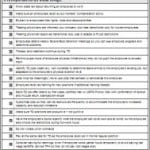14 Steps To Implementing Your Transitional Duty Program A company’s Transitional Duty Program is established to provide continuous employment for employees who cannot perform all job functions temporarily because of a work-related injury or illness.
A good company lets their employees know their goal is to ensure every employee remains an active part of the workforce.
The Three Phases of Implementing a TD Policy Explain the TD Work Assignment Include information on compensation benefits to injured workers’ compensation Discuss the purpose of periodic reviews Explain the Transitional Work Assignment
Click Link to Access Free PDF Download
“13 Research Studies to Prove Value of Return-to-Work Program & Gain Stakeholder Buy-In”
1. The company attempts to find a job that is similar to the employee’s original job.
2. Participation in the Transitional Duty Program is a condition of employment.
3. If an employee’s original job cannot be modified to accommodate transitional duty restrictions or if another job cannot be found at the original work-site then the employee may be transferred to a nearby location for the transitional duty period.
4. All transitional duty assignments occur during regular business hours of the location.
5. If the original job unit cannot accommodate the employee with a transitional duty assignment, the employee works at no cost to the new location.
6. If the employee does not want to perform the transitional duty position offered, eligibility for 12 weeks of unpaid leave under the Family and Medical Leave Act may be possible.
7. However, employees do not receive workers’ compensation benefits for FMLA leave. Such employees should consult the Human Resources Department for information about this option.
TD Information on Compensation for the Injured Employee
1. Employees on transitional duty assignment are ineligible for overtime.
2. If transitional duty is unavailable, the employee is paid for lost work time in accordance with applicable state law.
3. If transitional duty is available and the employee refuses the assignment, lost wage benefits are denied if allowed under state law, because the employee voluntarily withdrew from the workforce, not because of the injury.
FREE DOWNLOAD: “13 Research Studies to Prove Value of Return-to-Work Program & Gain Stakeholder Buy-In”
The Purpose of Transitional Duty Periodic Review
1. In no case will a transitional duty position last more than 120 days and the employee must always be progressing, improving.
2. When employees reach maximum medical improvement, they return to their original positions.
3. If an employee reaches maximum improvement and is unable to resume the pre-injury position, if required by the Americans with Disabilities Act, the company will offer another position, with or without a reasonable accommodation, if one is available.
4. If no other position is available, the employee will be separated from the company.

Author Robert Elliott,executive vice president, Amaxx Risks Solutions, Inc. has worked successfully for 20 years with many industries to reduce Workers’ Compensation costs, including airlines, health care, manufacturing, printing/publishing, pharmaceuticals, retail, hospitality and manufacturing. He can be contacted at: Robert_Elliott@ReduceYourWorkersComp.com or 860-786-8286. We are accepting short articles* (200-300 words) on WC cost containment. To: Info@WorkersCompKit.com. *Non-compensable.
WC Best Practices IQ Test: http://www.workerscompkit.com/intro/ WC Books: http://www.reduceyourworkerscomp.com/workers-comp-books-manuals.php Return to Work in Unionized Companies http://reduceyourworkerscomp.com//Return-to-Work-Programs-Unionized-Companies.php
Do not use this information without independent verification. All state laws vary. You should consult with your insurance broker about workers’ comp issues.
©2008 Amaxx Risk Solutions, Inc. All rights reserved under International Copyright Law.



